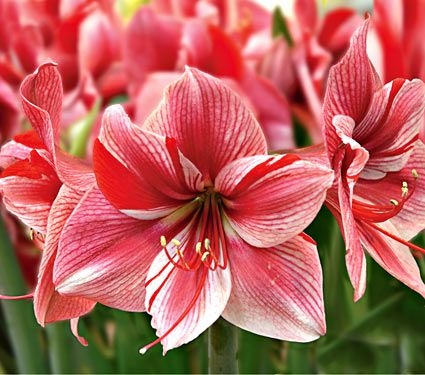Advice for the Home Gardener from the Help Desk of the
UC Master Gardener Program of Contra Costa County

MGCC's Help Desk Response: Thank you for contacting the UC Master Gardener Program Help Desk about the issues with your precious amaryllis bulb.
Two things that we discussed when reviewing the status of your prized amaryllis:
1. The container may be too large for the bulb. Amaryllis bulbs like to be potted in narrow and shallow containers.
2. The soil in your container appears to be moist. As mentioned in our previous emails on this subject, amaryllis do not like wet feet. They like to be kept in fast draining soil and only watered when the top two inches of soil feels dry.
We suggest that you correct these issues first in order to successfully grow your bulb.
For potted amaryllis, you don't need a great quantity of potting mix, because the bulbs grow and flower best when not over-potted. A 4-inch bulb only needs a pot 6 inches wide by 6 inches deep. The top one-third of the bulb should not be covered with soil, but left bare and protruding above the soil. As the bulb grows, move it gradually to larger pots, but still with a pot not much larger than the bulb itself. This prevents over-watering and waterlogged soil, which would rot the bulb.
We identified your flying insect as a fungus gnat. They are common in poorly drained soil or soil that is constantly wet (over-watered). Fungus gnats are a type of fruit fly that unfortunately either already exist in other potted plants in your home or patio, or may have come in with a new bag of potting soil.
Most of the fungus gnat's life is spent as a larva and pupa in organic matter or soil, so the most effective control methods target these immature stages rather than attempting to directly control the mobile, short-lived adults.
Physical and cultural management tactics—primarily the reductions of excess moisture and organic debris (such as dead leaves)—are key to reducing fungus gnat problems. We also suggest considering the use of the biological insecticide Bacillus thuringiensis (BT). This product is readily available in retail nurseries and garden centers, so it may be the most convenient for you to use. Just ask your favorite nursery for BT and then follow the package directions.
Here is additional information about fungus gnat control and prevention:
http://ipm.ucanr.edu/PMG/PESTNOTES/pn7448.html
Also, please see the attached information on proper use of pesticides:
http://ipm.ucanr.edu/PMG/PESTNOTES/pn74126.html
The beauty of amaryllis bulbs is that they are forgiving and easy to grow, so we want to help get you to the point of little worry and care for your grandmother's bulb!
If you have more questions, please do not hesitate to contact us again.
Help Desk of the UC Master Gardener Program of Contra Costa County (SLH)
Note: The UC Master Gardeners Program of Contra Costa's Help Desk is available year-round to answer your gardening questions. Except for a few holidays, we're open every week, Monday through Thursday for walk-ins from 9:00 am to Noon at 75 Santa Barbara Road, 2d Floor, Pleasant Hill, CA 94523. We can also be reached via telephone: (925)646-6586, email: ccmg@ucanr.edu, or on the web at http://ccmg.ucanr.edu/Ask_Us/ MGCC Blogs can be found at http://ccmg.ucanr.edu/HortCoCo/ You can also subscribe to the Blog (http://ucanr.edu/blogs/CCMGBlog/).

